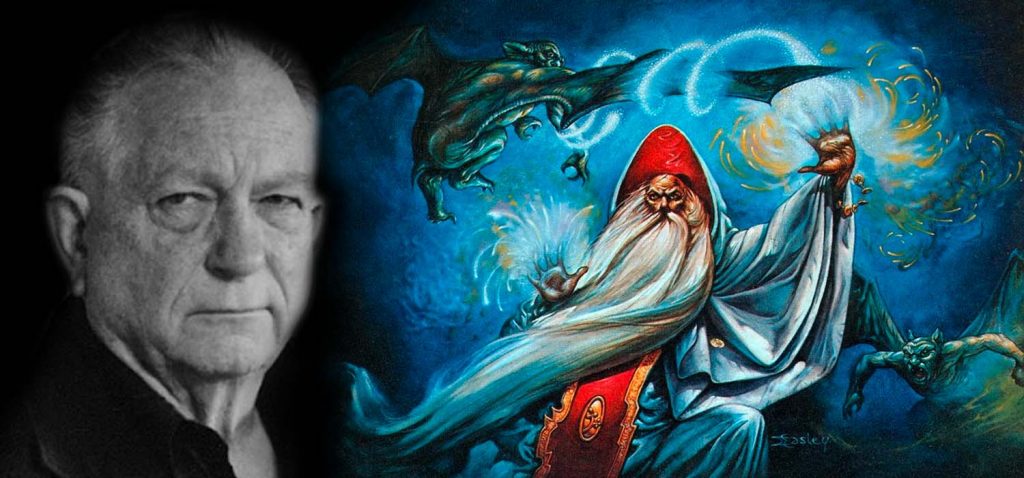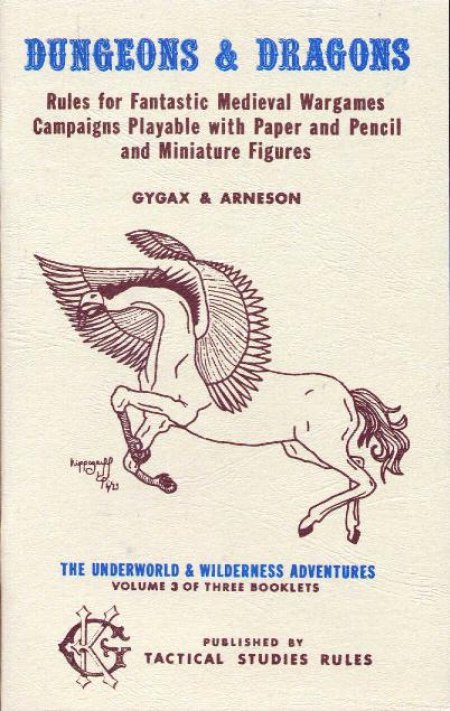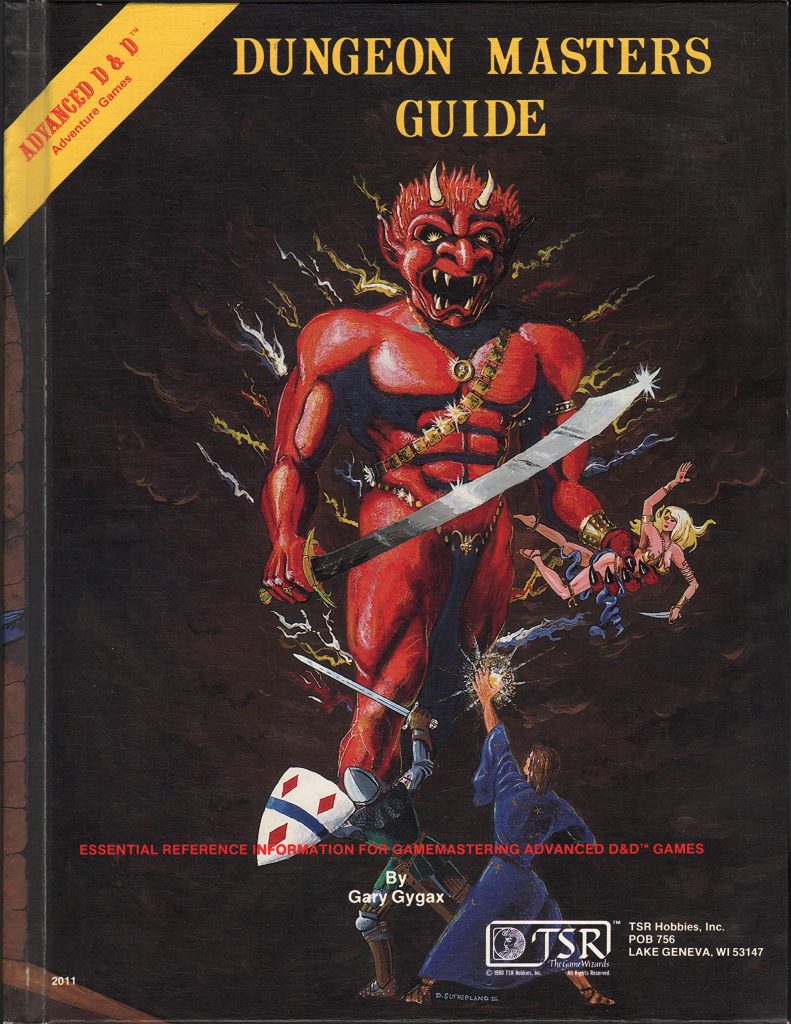
Jack Vance’s Influence on Dungeons & Dragons
by Bill Ward
“Turjan … descended to his study … The tomes which held Turjan’s sorcery lay on the long table of black steel or were thrust helter-skelter into shelves. These were volumes compiled by many wizards of the past, untidy folios collected by the Sage, leather-bound librams setting forth the syllables of a hundred powerful spells, so cogent that Turjan’s brain could know but four at a time.”
~ Jack Vance “Turjan of Miir,” The Dying Earth
Did you know that ‘Vecna’—he of the disembodied hand and eyeball—is a deliberate anagram of ‘Vance?’ Gary Gygax made no secret of his love for the work, and person, of Jack Vance, and Vance’s Dying Earth stories in particular were often cited (see Appendix N) by Gygax as a major influence on the genesis of Dungeons & Dragons. Most prominently, of course, in what came to be known as the ‘Vancian magic system’—a term that emerged from the world of RPGs rather than any literary fandom—but there are many other elements, and indeed a prevailing tone, in D&D that are inspired in whole or in part by the works of Jack Vance.
‘Vancian magic’ is more specifically the magic of the Dying Earth series of stories set in Vance’s wildly-imaginative far future world of double-crossing magicians, amoral rogues, strange dead end cultures, lost artifacts, and ancient technology. A decadent, fallen age, in which most everything of value has been lost to time, magic in the Dying Earth is a mysterious and mostly lost art, jealously guarded by its few practitioners, and extraordinarily powerful in its effects. Few can master more than a handful of spells at a time, the words themselves almost a living force that must be mentally grappled with and overcome, ‘forced’ into the sorcerer’s brain where it seethes with barely restrained potential. Once such a spell it uttered—and nearly all of these spells have what D&D fans would term a ‘verbal component’—it is purged utterly from the mind, absolutely wiped clean, until the wizard once again consults his tomes of lore.
“Mazirian made a selection from his books and with great effort forced five spells upon his brain: Phandaal’s Gyrator, Felojun’s Second Hypnotic Spell, The Excellent Prismatic Spray, The Chain of Untiring Nourishment, and the Spell of the Omnipotent Sphere.” – “Mazirian the Magician” The Dying Earth
All of this is old hat to fans of D&D and even RPGs in general, so ubiquitous has the concept become, even as it is modified over time to suit different games or play-styles. But it was a new concept when Vance came up with it, a sort of further systematization of the more amorphous concept of a spell-wielder mastering arcane lore and, through force of will, speaking words of power to alter reality. In Vance, magic is at once somewhat more akin to technology, in that it is quantifiable, but it is also a barely-understood force forever outside of the magician’s themselves. In some ways, despite their hoarded erudition, the magicians of the Dying Earth are like cavemen in possession of a neutron bomb.
In “Mazirian the Magician,” the second story/chapter in The Dying Earth, we see the perfect outline of Vancian magic. Early in the story, Mazirian is attacked by one of his science experiments, and he is as helpless as anyone would be without his memorized spells, smashing the thing with a beaker from his work table. He then prepares his ill-intentioned pursuit of a beautiful and mysterious woman by carefully selecting which spells he might need for his adventure. The story unfolds as an extended chase in which Mazirian expends one spell after another, destroying various attackers that seek the thwart him (perhaps these could be termed ‘random encounters’), walking across the floor of a lake, and surviving the collapse of a ruined temple. But, like a gunfighter of old, he only has so many shots before he’s firing on an empty cylinder, and he once again—and for the final time—finds himself powerless and in peril with a mind emptied of magic. The nature of the magic in Vance’s world is perhaps as much about creating an effective storytelling device as it is anything else.
Of course, it isn’t just the way spells are memorized and cast in Vance’s world that were a big influence on D&D, it’s the wildly colorful and evocative names that became central to the way in which magic was presented in RPGs. The Spell of Forlorn Encystment, Phandaal’s Mantle of Stealth, Call to the Violent Cloud, The Spell of the Macroid Toe (!) and, yes, The Excellent Prismatic Spray, all communicate wonder and suggest a provenance, with just a hint of Vancian absurdity thrown in for good measure. The same is true for the many artifacts of potent magic (or technology?) strewn throughout the Tales of the Dying Earth, items such as the Scintillant Dagger, Laccodel’s Rune, IOUN stones, the Expansible Egg, Live Boots, The Skybreak Spatterlight—these and dozens more are discovered, equipped, coveted, and fought over throughout these stories.
Certainly, names of power for potent artifacts is nothing new, going right back to the dawn of legend, but it is doubtful that Homer, Mallory, or Tolkien could inspire D&D treasure tables or magic item lists the way Vance did. From boot-polish that confers null-gravity to kicked objects, gemstones that always return to the user’s hand when lost (or spent), amulets detecting poison, lenses that allow one to see in the perfect realm of the Overworld, ropes that expand on demand, salves that render a blade indestructible, a ring that permits a view of all of one’s ancestors, a tube that projects blue concentrate, and a horn that allows the dead to utter twenty final words—all of these and scores upon scores more of items of rare and arch imagination color the tales set in Vance’s world. And, speaking of treasure tables:
“Cugel found articles of every description: garments new and old … old tools and broken weapons; bangles and trinkets; tarnished filigrees, crusted cameos, gemstones … silver bowls, ivory spoons, porcelain vases, gnawed bones and shining teeth of many sorts …” – The Eyes of the Overworld
The above is part of the frantic search for some spellbooks in the turned-inside-out lair of some vicious rat-men. Cugel, the original ‘murder hobo’ archetype and patron saint of every Chaotic Neutral power player ever to roll a d20, has just successfully cast a spell that rendered the underground warren in which he had been imprisoned inverted vis a vis the outside world, spewing its entire contents (including Cugel) above ground. Nothing at all like a real magician, Cugel nevertheless crams a spell into his mind and successfully executes it—surely this very scene is the inspiration for a high-level Thief’s ability to read scrolls in Dungeons & Dragons! Further efforts at spell casting prove … less than successful.
Gygax cites Cugel and Roger Zelazny’s Shadowjack (Jack of Shadows) as his primary inspiration for the Thief class in D&D, and I’d go one further and say that Cugel is practically the inspiration for the notion of a Player Character himself. Not that everyone isn’t capable of being the protagonist of his or her own story, but the utterly unrooted Cugel’s picaresque serialized romps, which alternate unflaggingly between the extreme poles of skin-of-his-teeth survival and the amoral pursuit of abject avarice, feels a lot like the ‘kill ’em and take their stuff’ mentality of a lot of early adventure gaming. And, while on the subject of taking their stuff, here we see a Thief using Detect Traps, complete with a ten-foot pole:
“Presently [Cugel] arose to his feet … then set about a cautious inspection of the manse, alert for traps, lures or deadfalls which the whimsical Iucounu might have established in order to outwit or beguile intruders. He was especially vigilant during his inspection of Iucounu’s workroom, probing everywhere with a long rod, but if Iucounou had set forth snares or beguilements, none were evident.” –The Eyes of the Overworld
Unlike the heroes of high fantasy—themselves undoubtedly another vein of inspiration for D&D—Vancian heroes usually operate with more personal goals in mind. Cugel, of course, is venal and completely absorbed with his own well-being—but then again, on his dying world, the great mass of humanity seems little better. Gygax’s recommended reading list of inspirational texts, Appendix N, is overwhelmingly skewed toward the personal stakes style adventures of the sword-and-sorcery and pulp adventure end of the spectrum—and most adventuring parties in Dungeons & Dragons have more in common with Conan, the Gray Mouser, Satampra Zeiros, and Cugel the Clever than they do with Aragorn or King Arthur.
“Aside from ideas and specific things, the very manner in which Jack Vance portrays a fantasy environment, the interaction of characters with that environment, and with each other, is so captivating that wherever I could manage it, I attempted to include the “feel” he brings to his fantasy tales in the AD&D game. My feeble ability likely managed to convey but little of this, but in all I do believe that not a little of what fans consider to be the “soul” of the game stems from that attempt.” – Gary Gygax, “Jack Vance and the D&D Game,” Profantasy, 2001
Like any author that breaks new ground and mints something iconic and original, Gary Gygax and his creation were more than the sum of their inspirations. His Appendix N list of influences should not be considered ‘Jack Vance and the rest,’ for there is an absolute wealth of material spread over many of those authors and their stories that can clearly be seen reflected in Gygax’s great work. But Vance does stand out as one of the absolute major elements that went into not only the specifics of Dungeons & Dragons, but the birth of the role-playing game itself. Dying Earth’s potentially unlimited setting, its rich and colorful magic, its odd peoples, monsters, and situations, even the science fantasy elements of incomprehensible and wildly powerful technology, all found their way into the father of all role-playing games. And perhaps above all, the playful spirit of episodic adventuring, the joy of wielding potent, reality-altering powers, and the just plain fun of solving challenge after challenge to live to fight another day is as Vancian as any magic system, and at the heart of what informs the imaginative landscapes of millions of modern gamers around the world to this day.










